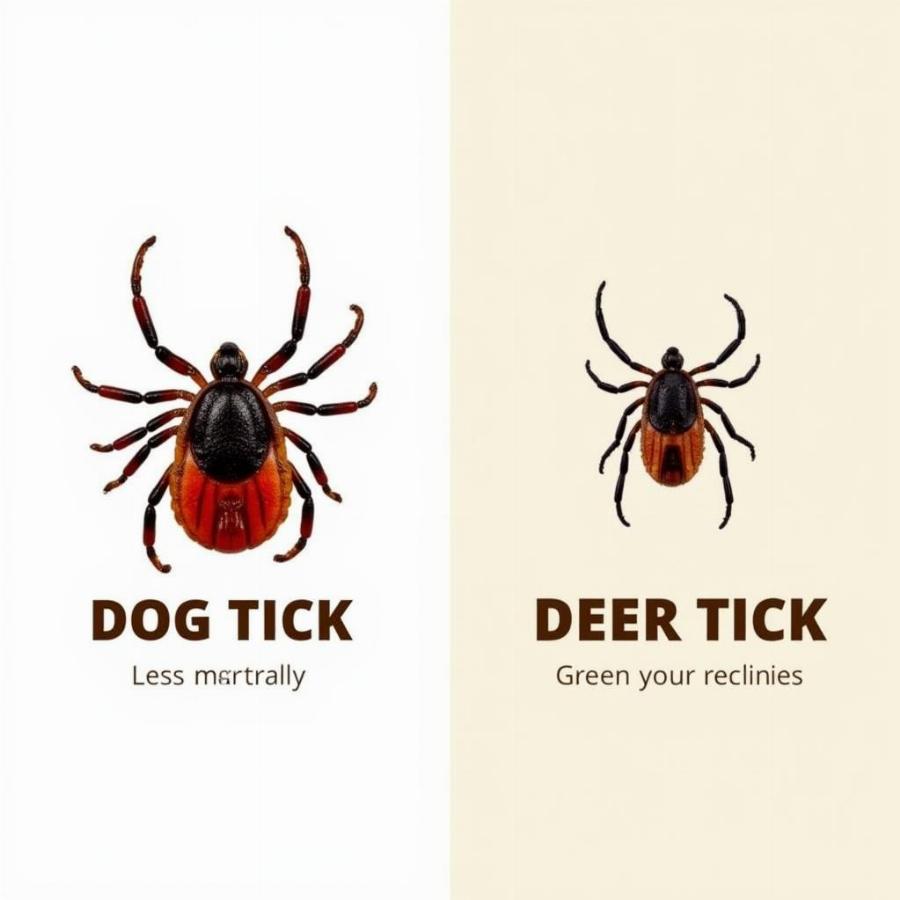Deer ticks, notorious carriers of Lyme disease, pose a significant threat to both humans and animals, including our beloved canine companions. Understanding the difference between a common dog tick and a deer tick is crucial for effective prevention and treatment. This article will delve into the specifics of identifying deer ticks, the dangers they present to dogs, and the essential preventative measures you can take to protect your furry friend.
Identifying the Deer Tick (Blacklegged Tick)
 Phân biệt hình dáng bên ngoài của bọ ve chó và bọ ve hươu
Phân biệt hình dáng bên ngoài của bọ ve chó và bọ ve hươu
So, how can you tell a deer tick apart from other ticks commonly found on dogs? Deer ticks, also known as blacklegged ticks, are significantly smaller than dog ticks. Adult females have a characteristic reddish-brown body with a black shield behind their head, while males are entirely black. Their legs are noticeably darker than those of dog ticks. Nymphs, the immature stage of deer ticks, are even smaller and can be as tiny as a poppy seed, making them difficult to spot.
The Dangers of Deer Ticks for Dogs
Deer ticks are the primary vectors of Lyme disease, a debilitating illness that can affect dogs just as it does humans. Lyme disease is caused by the bacterium Borrelia burgdorferi and can lead to a range of symptoms in dogs, including lameness, fever, lethargy, swollen lymph nodes, and loss of appetite. If left untreated, Lyme disease can cause serious kidney complications and even neurological issues. Beyond Lyme disease, deer ticks can also transmit other diseases such as anaplasmosis and babesiosis, which can further compromise your dog’s health.
Preventing Deer Tick Bites in Dogs
Protecting your dog from deer ticks requires a multi-pronged approach. Regularly checking your dog for ticks, especially after walks in wooded or grassy areas, is essential. Use a fine-toothed comb to thoroughly inspect your dog’s fur, paying close attention to areas like the ears, armpits, groin, and between the toes. Several preventative products are available, including topical treatments, tick collars, and oral medications. Consult your veterinarian to determine the most appropriate option for your dog. Maintaining a tick-free environment in your yard by keeping the grass short, removing leaf litter, and creating a barrier of wood chips or gravel can also help reduce the risk of tick exposure.
How to Remove a Deer Tick from Your Dog
If you find a tick on your dog, it’s crucial to remove it promptly and correctly. Use fine-tipped tweezers to grasp the tick as close to the skin as possible. Pull upward with steady, even pressure, avoiding twisting or squeezing the tick. After removing the tick, clean the bite area with antiseptic and dispose of the tick by placing it in alcohol or sealing it in a bag.
What are the symptoms of Lyme disease in dogs?
Lyme disease symptoms can manifest differently in dogs, ranging from subtle to severe. The most common signs include:
- Lameness (often shifting between legs)
- Fever
- Lethargy
- Swollen lymph nodes
- Loss of appetite
- Joint swelling and pain
If you notice any of these symptoms in your dog, consult a veterinarian immediately for diagnosis and treatment.
Are deer antlers safe for dogs to chew?
While deer antlers can be a natural chew treat for some dogs, they are not without risks. Hard antlers can cause dental fractures, especially in aggressive chewers. deer antler for dogs provides more insights into this topic. For alternative chew options, you might consider split antlers, which are generally softer. Learn more about split antlers for dogs.
Does plaque buildup increase the risk of tick infestation?
While there’s no direct link between plaque and tick infestation, maintaining good oral hygiene is crucial for your dog’s overall health. Consider adding plaque off for dogs to your dog’s routine for optimal dental health.
Conclusion
Protecting your dog from deer ticks and the diseases they carry is a vital aspect of responsible pet ownership. By implementing preventative measures, performing regular tick checks, and knowing how to remove ticks properly, you can significantly reduce the risk of your furry friend contracting Lyme disease or other tick-borne illnesses. Remember, vigilance and proactive care are key to ensuring your dog’s health and well-being.
FAQ
- What is the best way to prevent deer ticks on my dog? A combination of regular tick checks, preventative medications (topical, oral, or collar), and yard maintenance is the most effective approach.
- How long after a tick bite can a dog develop Lyme disease? Symptoms typically appear 2-5 months after infection.
- Can humans get Lyme disease from their dogs? No, Lyme disease cannot be transmitted directly from dogs to humans. However, both can be infected by the same tick.
- Are all ticks carriers of Lyme disease? No, only certain tick species, primarily deer ticks, transmit Lyme disease.
- What should I do if I find an engorged tick on my dog? Remove it carefully with tweezers and contact your veterinarian.
- Can deer ticks infest my home? While less common than outdoors, deer ticks can be brought inside on clothing or pets.
- Are there any natural tick repellents for dogs? Some essential oils, like cedarwood and citronella, are believed to have tick-repelling properties, but their effectiveness is not scientifically proven.
You Might Also Be Interested In:
Beaut Dogs is your one-stop resource for all things canine. We’re dedicated to providing valuable information and expert advice to help you navigate the wonderful world of dog ownership. From breed-specific insights to comprehensive care guides, we’ve got you covered. When you need support, reach out to us at [email protected] (Email address) and let Beaut Dogs provide you with detailed and accurate answers. Visit us at https://beautdogs.com.